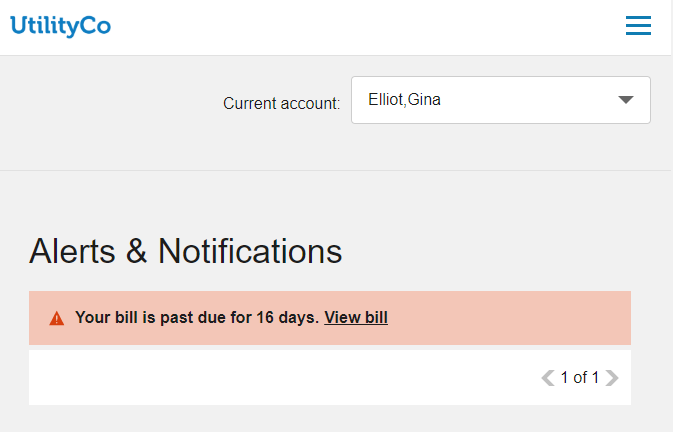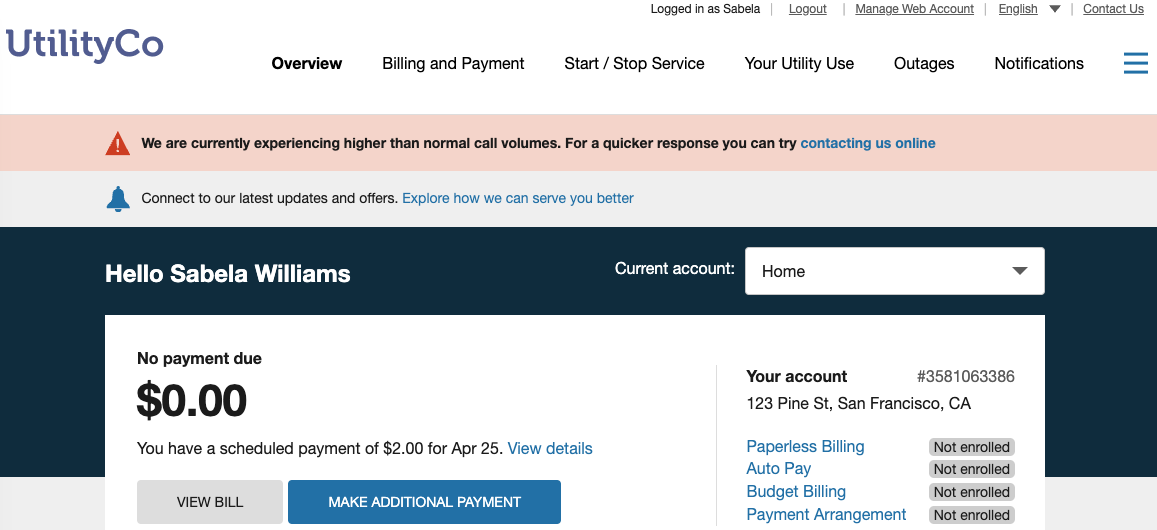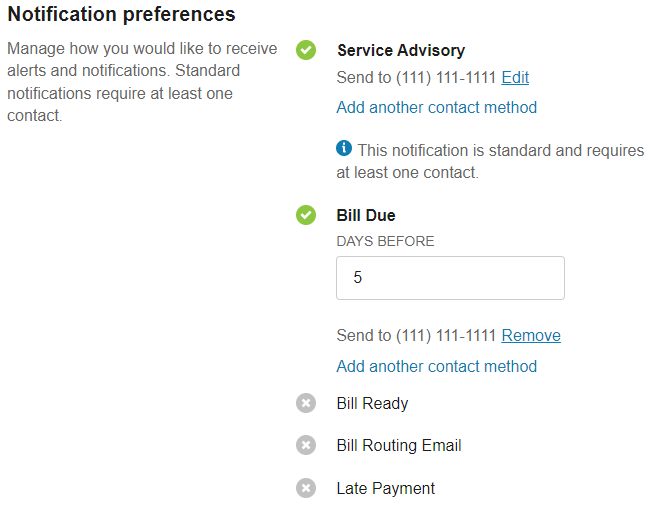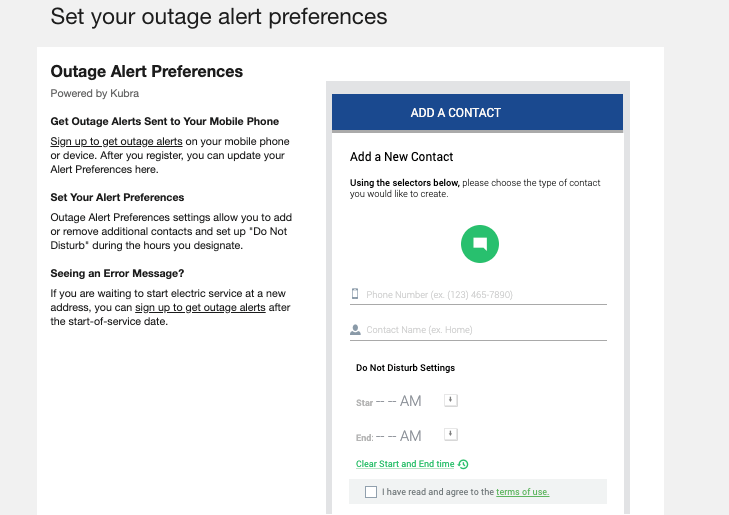Notifications
Customers can review and modify their notifications, alerts, and communications for their account, as well as define the contact methods for each applicable communication. Digital Self Service - Transactions supports a wide variety of notifications that can be viewed by a customer when they sign in to their account or sent to contacts that the customer creates.
Note: Customers can select their account using the Current account drop-down list. For more information, see Account Selector.
User Experience
Alerts and Notifications
Customers are presented with important alerts and notifications about their account in the Overview Dashboard and the Notification Center. Critical information, referred to as alerts, are displayed directly on the Overview Dashboard, and customers can scroll through all critical alerts. The Overview Dashboard also displays a single item for non-critical notifications. Customers with more than one non-critical notification see a summary of notifications on the Overview Dashboard with the total number of non-critical notifications, along with a link to the Notification Center to view all alerts and notifications.
All active alerts and notifications are available to customers in the Notification Center. Alerts and notifications cover areas such as payments, billing information, account status updates, and guest user invitations. A message is displayed for customers that have no active alerts or notifications.

Payment Status Alerts and Notifications
Customers receive alerts and notifications for status updates to recent payments, including:
- Payment received
- Payment scheduled
- Payment failed
- Payment rejected
- Scheduled payment canceled
- Payment submitted
- Automatic payment received
- Automatic payment failed
- Automatic payment rejected
- Automatic payment submitted
Bill Due Alerts and Notifications
Customers receive alerts and notifications for their bills, including:
- Bill past due
- Bill due in future
- Bill due today
Account Status Alerts
Customers receive alerts for critical account status updates, commonly as a result of unpaid bills, including:
- Service will be suspended
- Service suspended
- Service restored
Guest User Invitations
Customers receive notifications when there is a pending guest user invitation waiting for the guest user to accept.
General Announcements
General announcements are vital messages presented to customers directly on the portal's Overview Dashboard. These messages can encompass a wide range of information, from critical notifications such as widespread power outages or impending severe weather conditions, to informative updates about scheduled maintenance on the portal or exciting new rebate and promotion programs. Urgent alerts, such as emergency situations, are given top priority and appear prominently at the beginning of the notifications list, ensuring that customers stay informed about essential information directly within the portal. More informative general announcements can be defined as non-urgent and displayed alongside other notifications without heightened priority. The image below provides an example of urgent and non-urgent general announcement banners.
Note: For information on configuring general announcements, see the Oracle Utilities Opower Digital Self Service - Transactions Configuration Guide

Account Notifications
The members of a utility account with the required permissions can set their account notification preferences, including:
Note: All modifications are made for the utility account and not the web login. Customers can have different settings for each of their accounts by selecting the account they want to modify from the account drop down list.

Contact Methods
Contact methods provide delivery methods for outbound account notifications. A minimum of one primary contact method is required for each contact type that a customer has saved for their account. For example, if a customer includes phone number contacts for their utility account, one phone number must be defined as the primary phone contact. The primary contact methods cannot be deleted but can be modified.
Customers can add or delete contact methods from the contact list at any time. When deleting a contact method, any notification preferences assigned to a specific contact are also removed. If the deleted contact method was the only contact method set to receive the utility bill through email, the bill is automatically sent to the primary email for the account.
Bill Delivery
Customers can choose to receive their bill through standard mail or through email. When a customer enrolls in paperless billing, the email address being used for delivery is shown, along with a link to unenroll. When the customer is sent bills through standard mail, a link is shown to allow customers to enroll in paperless billing. A customer's mailing address can be used for various utility communications in addition to bills and therefore a customer can update their mailing address regardless of their enrollment in paperless billing.
Notification Preferences
Notification preferences, as defined by the utility, can subscribe customers to account notifications. These preferences are used to enroll a customer in outbound notifications, which are sent directly to the contacts the customer selects for the respective notification. These notifications can complement the Notifications that are displayed in the Notification Center. Common notifications can include:
- Bill is ready
- Bill is due
- Programs and offers
- Bill is past due
- Payment received
- Budget billing changes
Energy Use Communications
The account manager for a utility account can set their energy use communications and alerts using the following options:
Note: Energy use communications are part of the Digital Self Service - Energy Management features, and are an optional add-on, available through the Oracle Utilities Opower Digital Self Service - Energy Management Cloud Service.
- Energy Use Communication Recipients
- Home Energy Reports
- Weekly Energy Updates
- High Usage Alerts
- Peak Pricing Alerts
Note: All modifications are made at the utility account and not the web login. Customers can have different settings for each of their accounts by selecting the account they want to modify from the account drop down list.

Energy Use Communication Recipients
Energy use communications can be sent to any recipient. The Message Preferences section is displayed once for each recipient on the account, and provides a list of the available communications and alerts that the recipient can receive. This section of the widget can be expanded or collapsed by clicking Details.
The products and channels that are displayed for each recipient depend on:
- The products and reports that are available from the utility.
- The communication types included for the recipient. For example, do they have both an email and a phone number?
- Whether the recipient is the primary recipient on the account.
Each applicable channel can then be selected or cleared for each recipient of a product. Printed reports can be sent only to the mailing address for the primary account recipient. Additional recipients cannot select printed reports.
Note: Recipients are different than the contact methods used for billing communications. If the same contact information should be used for both billing and energy use communications, an applicable contact method and recipient must both be created.
Behavioral Load Shaping
This section, which might also be called Rate Coach Emails, controls whether a customer receives Behavioral Load Shaping email communications. Behavioral Load Shaping communications are only available for the email channel. For more information, see the Oracle Utilities Opower Behavioral Load Shaping Cloud Service Product Overview.
Home Energy Reports
Home Energy Reports are user-friendly communications that provide personalized information to customers about their energy use. Customers can choose to receive HERs through standard mail or email. Home Energy Reports sent through standard mail can only be sent to the primary mailing address for the utility account. For more information on Home Energy Reports, see the Oracle Utilities Opower Energy Efficiency Cloud Service Product Overview .
Weekly Energy Updates
Weekly Energy Updates are email notifications that compare the energy use for a premise to that of similar neighbors. For more information on Weekly Energy Updates, see the Oracle Utilities Opower Proactive Alerts Cloud Service Product Overview.
High Usage Alerts
High usage alerts are digital communications sent through email, SMS, and voice to inform customers when they are expected to receive a higher energy bill.
A personalized alert threshold is available to customers who have High Bill Alerts AMI. For information on the applicable Cloud Service, see the Oracle Utilities Opower Proactive Alerts Cloud Service Product Overview. Depending on the characteristics of a customer's accounts, the customer is provided one of the following options to define an alert threshold:
- Cost threshold: The cost threshold allows customers to specify a dollar amount as their personalized threshold. When the cost threshold is set, the customer will only receive a high bill alert when their cost exceeds the cost threshold. All active utility accounts for a customer must have modeled rates and are not defined as budget billing accounts for the customer to define a cost-based threshold.
If a customer does not set their personalized threshold, they will only receive high bill alerts when they exceed the combined usage and cost threshold set by the utility. The recommended combined threshold is 30 percent. - Usage threshold: The usage threshold allows the customer to set a percentage-based personalized threshold. When the usage threshold is set, the customer will only receive an alert when their energy use exceeds that threshold for the same billing period the previous year. The default usage threshold is 30 percent. The usage-based threshold is available to customers who are ineligible to define a cost-based threshold. This applies to customers with at least one active account without modeled rates or defined as a budget billing account.
Peak Pricing Alerts
Peak pricing alerts are digital communications sent through email, SMS, and voice to inform customers of peak pricing events. Customers can receive either Peak Time Rebate or Behavioral Demand Response communications. For more information on the applicable Cloud Services, see the Oracle Utilities Opower Behavioral Demand Response Cloud Service Product Overview and the Oracle Utilities Opower Peak Time Rebates Cloud Service Product Overview .
Outage
Outages are a main reason for customers to log in to their utility account or contact their utility's customer service. Depending on the implementation, customers are presented with information and options to receive outage notifications.
Integration with Customer Care and Billing
Using the Customer Care and Billing outage notification integration presents outage notifications along with other notification preferences:

Third-party Integration with Kubra
Customers can select the channels to receive outage alerts, such as mobile push alerts, text messages, email, or automated phone calls. Contact information for each channel must be provided. Using Kubra’s Notifi Alerts and Preferences Management integration presents outage notifications in a dedicated set of outage notification preferences:

User Experience Variations
Customers Enrolled in Payment Extensions
Alerts related to the due date of a customer's bill are impacted when a customer enrolls in payment extensions. When a customer enrolls in payment extensions, past due notifications are hidden for the customer. Alerts that relate to the due date such as Bill due today and Bill due in future are modified to reflect the due date of the payment extension.